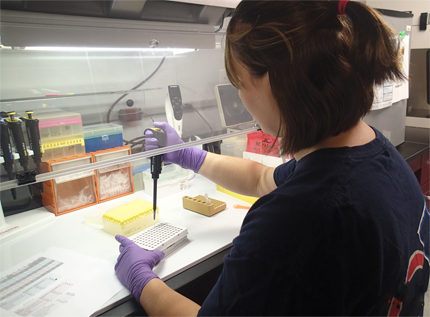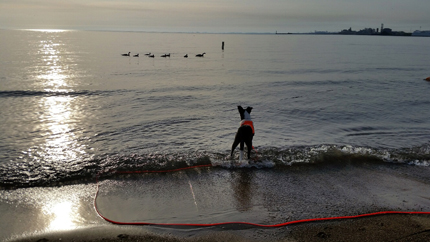5585 Guilford Road • Madison, WI 53711-5801 • 608-273-8080 • Fax 608-273-2021
www.agronomy.org
Twitter | Facebook
NEWS RELEASE
Contact: Hanna Jeske, Associate Director of Marketing and Brand Strategy, 608-268-3972, hjeske@sciencesocieties.org
Cause of E. coli beach closings? Gulls
May 23, 2018 - This summer, during the middle of a heat wave, you might want to enjoy a swim at your local beach. But summer is also the time of algal blooms and E.coli alerts—and that can put a damper on your plans to cool off.
 Researchers have recently published results identifying the major sources of E. coli breakouts on several beaches on Lake Michigan. They have also researched an effective method of reducing the breakouts and the resulting beach closings.
Researchers have recently published results identifying the major sources of E. coli breakouts on several beaches on Lake Michigan. They have also researched an effective method of reducing the breakouts and the resulting beach closings.
“It’s important to encourage access to these important natural areas,” says Meredith Nevers. Nevers is a research ecologist with the U.S. Geological Survey. “Finding and eliminating the source of E. coli, which is one reason for closing beaches, can lead to fewer beach closings and more people getting to the beach.”
Nevers worked with colleagues from the USGS as well as Michigan State University. The team sampled water from Lake Michigan beaches in Indiana in 2015 and 2016.
The researchers studied a region that includes the Grand Calumet River, Indiana area of the Great Lakes. “This was identified as an area of concern in 1987 by the International Joint Commission,” says Nevers. “The area had a high amount of pollution, as well as a high number of beach closings. The Grand Calumet River is low-gradient, meaning its flow isn’t usually very fast. This can cause pollution to stay in place, rather than flowing out of the river to Lake Michigan. It received over 100 years’ worth of industrial and municipal waste before the EPA stepped in. Removing long-buried contaminants is one area of research by other resource managers. Our team is working on more current sources of contamination.”
 When determining whether to close a beach, local authorities measure total E. coli but do not focus on the source. Closing the beaches protects swimmers from illness. The E. coli itself may not be the cause of human health risks, but its presence tends to indicate that more harmful pathogens are in the water. The USGS/Michigan State team wanted to determine the source of the E. coli as well as possible ways to prevent high levels.
When determining whether to close a beach, local authorities measure total E. coli but do not focus on the source. Closing the beaches protects swimmers from illness. The E. coli itself may not be the cause of human health risks, but its presence tends to indicate that more harmful pathogens are in the water. The USGS/Michigan State team wanted to determine the source of the E. coli as well as possible ways to prevent high levels.
The team turned to “fecal markers”—the source of which is poop. Scientists can test to determine if the E. coli comes from feces from human, canine, or bird populations. Determining the source of E. coli can provide information to begin restoration activities.
In this case, the team was looking at gull species. Across all of the sampling sites, gulls were identified as the major source of E. coli that led to beach closings.
To be fair, it’s not just gulls in the avian category that create nuisance problems. Canada geese and mallard ducks have been in the news for creating messy—and contaminated—beach fronts. Additionally, the research team found human sources of E. coli, most likely from wastewater treatment plants that need fixing or their overflow after rain events. Canine E. coli was also in their samples. However, the majority of the E. coli problems were caused by gulls at all beaches studied.
Once the team determined the source of E. coli, they turned to effective methods of control. Trained dogs patrolled the beaches from sunrise to 7 PM for one month in 2015, and from June through September in 2016. The dogs reduced gull abundance by close to 100%. They also reduced the number of times per day that gulls were present on or near the beaches by 93%. Beach closings were down, especially at sites with this canine gull deterrence program.
 “Restoring the Grand Calumet River so it can supply all of its ecosystem functions should improve overall shoreline health,” says Nevers. “Continued efforts will help to re-establish native plant and animal communities, and improve public access to the shoreline.”
“Restoring the Grand Calumet River so it can supply all of its ecosystem functions should improve overall shoreline health,” says Nevers. “Continued efforts will help to re-establish native plant and animal communities, and improve public access to the shoreline.”
Future research could study other rivers that flow into Lake Michigan. They could also focus on exact sources of human E. coli and fix those problems.
What can you do to help improve beach conditions? Refrain from feeding any shorebirds, and bring your trash home with you or use trash receptacles. In addition, pick up your pet’s waste, and dispose of it properly. The researchers did find that canine E. coli was in the beach water and can be a source of beach closings.
The dogs that were used to help clean up the beaches were specially trained for their job of gull deterrence, and their handlers made sure the dogs “left no trace behind.”
Read more about this research in the Journal of Environmental Quality. The Great Lakes Restoration Initiative and the Indiana Department of Environmental Management supplied funding for the research.
Journal of Environmental Quality publishes original research, reviews and analyses, and environmental issue articles that address anthropogenic impacts on water, soil, and the atmosphere and pertain to some aspect of environmental quality in natural and agricultural ecosystems.